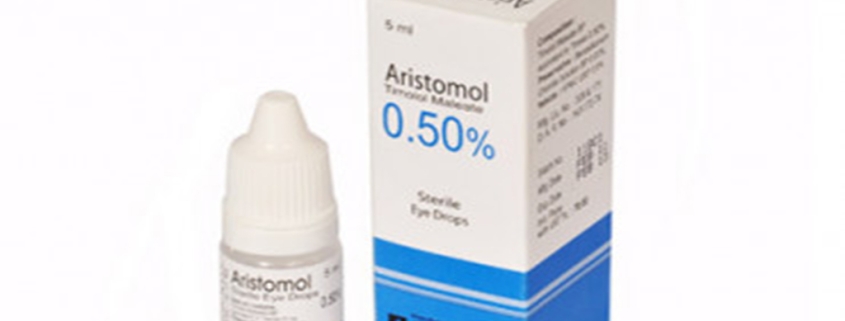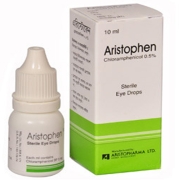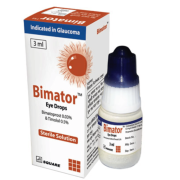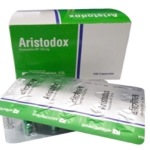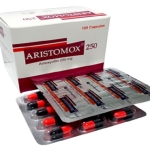Aristomol (Timolol)
Description
The action of Aristomol is usually rapid occurring approx. 20 minutes following ocular instillation. The maximum effect occurs in one to two hours and significant lowering of intraocular pressure has been maintained for periods as long as 24 hours with Aristomol 0.50%. Aristomol has the action of reducing elevated intraocular pressure, whether or not accompanied by glaucoma.Pharmacological characteristics of Timolol Maleate, the active ingredient of Aristomol Eye Drops, are: Non-selective beta blocking agent. No intrinsic sympathomimetic activity (I.S.A.). Non significant local anaesthetic effect (membrane stabilizer). Unlike miotics, Aristomol has practically no effect on pupil size or accommodation. No accommodative spasm or change in visual acuity are observed. As with other antiglaucoma drugs, a diminished responsiveness to Aristomol has been reported in some patients after prolonged therapy. Systemic absorption: Plasma levels following ocular instillation have not been specified.
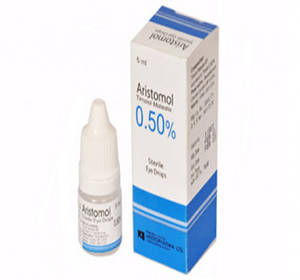
Presentation
Aristomol 0.5% Sterile Eye Drops: Each ml contains Timolol Maleate BP equivalent to Timolol basic 5 mg.
Indications
Ocular hypertension
Chronic open-angle glaucoma
Aphakic glaucoma
Dosage & Administration
The usual starting dose is one drop of Aristomol 0.50% in the affected eye twice a day.
If necessary the physician may institute a concomitant therapy:
Either a sympathomimetic or parasympathomimetic antiglaucoma ophthalmic solution,
Or systemically administered carbonic anhydrase inhibitors, in order to obtain a better response.
Since in some patients the pressure-lowering response to Aristomol may require a few weeks to stabilize, evaluation should include a determination of intraocular pressure after approximately 4 weeks of treatment with Aristomol. If the intraocular pressure is maintained at satisfactory levels, the dosage schedule may be changed to one drop once a day.
Contrainidications
Absolute bronchial asthma, bronchospasm, history of bronchial asthma or severe chronic obstructive pulmonary disease. Uncontrolled congestive cardiac insufficiency, cardiogenic shock High atrioventricular block (without apparatus) Raynaud phenomena, High bradycardia (pulse rate < 45 to 50 pulses/min.), Hypersensitivity to any component, relative combination with amiodarone.
Warning & Precautions
Sports person should take care that this specically contains an active product, which can induce in a positive way the tests made during antidoping controls.
As with other topically applied ophthalmic drugs, this drug may be absorbed systemically and lead to systemic effects of beta-blockers.
Cardiac insufficiency should be adequately controlled before starting therapy with Aristomol. In patients with a history of severe cardiac disease and in elderly patients, signs of cardiac insufficiency should be watched for and pulse rates should be checked.
Following administration of Timolol Maleate, severe respiratory reactions and cardiac reactions have been reported, including death due to bronchospasm in patients with asthma, and rarely death in association with cardiac failure. Patients already receiving a beta-blocker orally and who are given Aristomol should be observed for a potential additive effect either on the intraocular pressure or on the known systemic effects of beta-blockers.
Although Aristomol is well tolerated in glaucomatous patients wearing contact lenses as well as in aphakic patients, the wear of contact lenses should be avoided due to the risk of:
Decarease of lacrimal secretion due to beta-blockers.
Absorption on the lens of some components of the drug (Benzalkonium chloride).
Keratitis while wearing soft contact lenses due to Benzalkonium chloride.
Diabetes mellitus: Beta-blockers should be administered with caution in patients subject to spontaneous hypo-glycemia or to diabetic patients who are receiving insulin or oral hypoglycemic agents. Beta-blockers may mask the signs and symptoms of acute hypoglycemia.
Side effects
Aristomol is generally well tolerated. In clinical studies of Timolol Maleate the adverse reactions reported were-mainly:
Ocular: Symptoms of ocular irritation including conjunctivitis, blepharitis, keratitis, corneal hypoesthesis, visual disturbances including refractive changes, diplopia and ptosis.
Cardiovascular: Bradicardia, arrhythmia, hypotension, syncope, heart block, cerebrovascular accident, cerebral ischemia, congestive heart failure, palpitation, cardiac arrest.
Respiratory: Bronchospasm, respiratory failure, dyspnea.
Systemic: Headache, asthenia, nausea, dizziness, depression, fatique.
Drug interaction
Those of beta-blocking agents. Calcium inhibitors, catecholamine depending drugs, beta-blocking agents may lead to hypotension and/or severe bradycardia, and when combined with Aristomol may produce additive effects. Ophthalmic supervision is required in case of concomitant therapy with eye drops containing adrenaline (mydriasis may occur).
Use in special groups
Use in pregnancy: Aristomol has not been studied in human pregnancy.
Use in neonates: Timolol maleate is not recommended in premature baby and newborn.
Use in lactation: Beta blocker are excreted in the milk. The risk of hypoglycemia and bradycardia in nursing infants has not been evaluated. Breast-feeding is not recommended during treatment.
Use in children: Clinical studies in children have not been conducted.
Lactation: Beta-blockers are excreted in the milk. The risk of hypoglycemia and bradycardia in nursing infants has not been evaluated. Breast-feeding is not recommended during treatment.
Packing
Aristomol 0.5% Sterile Eye Drops: Each plastic dropper bottle contains 5 ml drops.

